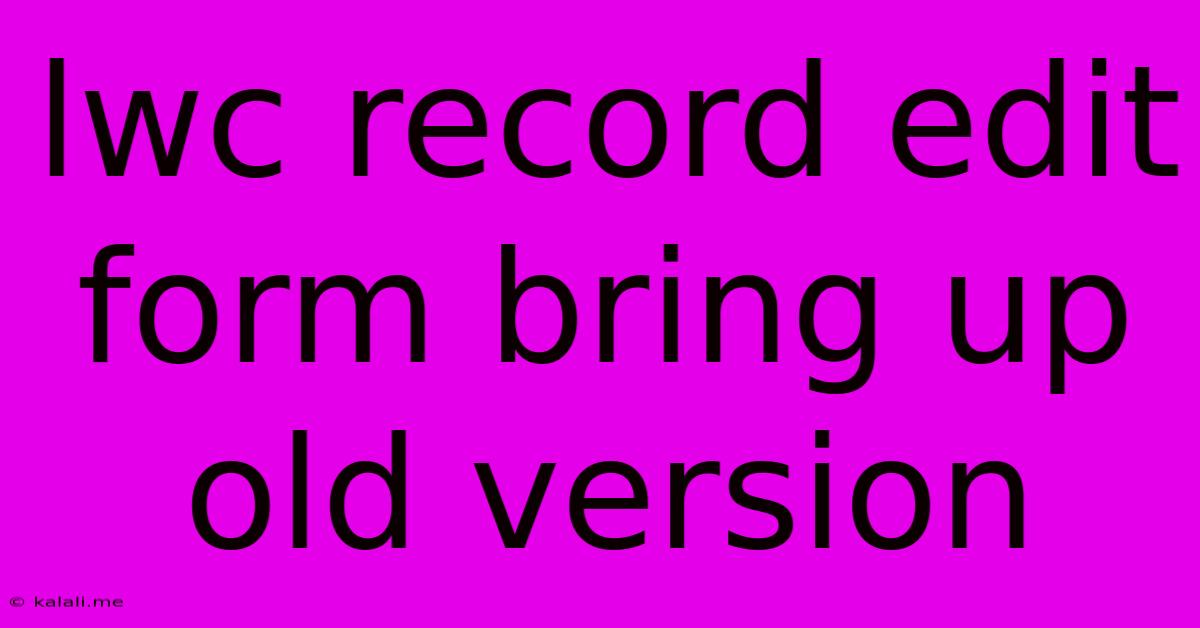Lwc Record Edit Form Bring Up Old Version
Kalali
May 23, 2025 · 3 min read

Table of Contents
Lightning Web Components (LWC) Record Edit Form: Accessing and Utilizing Old Versions
Accessing previous versions of a record within a Lightning Web Components (LWC) record edit form is a powerful feature that enhances data integrity and allows for efficient collaboration. This article explores different approaches to achieve this functionality, focusing on best practices and considerations for a seamless user experience. Understanding how to bring up old versions empowers users to review changes, restore previous data, and maintain a comprehensive audit trail.
Why Accessing Old Versions is Crucial
The ability to view and potentially restore previous versions of a record is critical for several reasons:
- Error Correction: Quickly revert to a previous state if edits introduce errors or inconsistencies.
- Collaboration & Auditing: Track changes made by different users, facilitating collaboration and accountability.
- Data Recovery: Restore data accidentally deleted or overwritten.
- Compliance & Governance: Maintain a complete audit trail for regulatory compliance requirements.
Methods for Accessing Old Versions in LWC Record Edit Forms
There isn't a built-in LWC component to directly display old record versions within a standard record edit form. However, you can achieve this functionality through various approaches:
1. Utilizing the Salesforce REST API:
This is the most flexible and robust method. Your LWC can leverage the Salesforce REST API to retrieve historical versions of a record. Specifically, the versions subresource of the object's REST API endpoint allows access to past versions.
- Steps:
- Fetch the record Id from the URL parameters.
- Construct a REST API request to retrieve the versions of the record using the record Id. Include necessary fields in the
fieldsparameter for efficient data retrieval. - Parse the API response and present the version data in a user-friendly format within the LWC. This might involve a table or a list of available versions.
- Allow users to select a specific version, retrieve its data using another API call, and potentially display it in a read-only mode for comparison.
2. Leveraging Apex Methods and Wrapper Classes:
For improved performance and to encapsulate complex logic, create an Apex class to handle the retrieval of record versions. This class can interact with the Salesforce API and return the data in a structured format suitable for your LWC.
- Steps:
- Create an Apex class with a method to retrieve record versions.
- Use the
Database.querymethod with appropriate SOQL to query the object's history. Consider usingCreatedDatefor easy version sorting. - Optionally create a wrapper class to structure the retrieved data, making it easier to handle within the LWC.
- Expose this Apex method as an @AuraEnabled method for LWC access.
- Call this method from your LWC using
wireto retrieve and display the version history.
3. Implementing a Custom Component:
For a more integrated experience, create a custom LWC component specifically designed to handle version display and potentially restoration. This component can be incorporated into your existing record edit form.
- Steps:
- Develop an LWC component that accepts the record Id as input.
- Implement the API calls (or Apex method calls) to retrieve and display version information.
- Design a user-friendly interface to allow the user to select and review different versions.
- Optionally add functionality to restore a chosen version (this would require careful consideration and potentially an approval process).
Considerations and Best Practices:
- Performance: Retrieving and displaying many versions can impact performance. Implement pagination or limit the number of versions displayed.
- User Interface: Design a clear and intuitive interface for version selection and comparison. Highlight changes between versions clearly.
- Security: Implement appropriate security measures to ensure only authorized users can access historical data.
- Error Handling: Implement robust error handling to gracefully manage API errors and data inconsistencies.
- Data Volume: For objects with a high volume of historical data, consider optimizing your data retrieval and display strategies.
By strategically utilizing the Salesforce REST API, Apex methods, or custom components, you can effectively integrate the capability to access old record versions within your LWC record edit forms, significantly improving data management and user experience. Remember to prioritize performance, security, and user experience when designing your implementation.
Latest Posts
Latest Posts
-
Why Did Jacob Wrestle With God
May 24, 2025
-
Burning The Candle At Both Ends
May 24, 2025
-
How To Use Laptop As Monitor
May 24, 2025
-
Substitute Brown Sugar For White Sugar
May 24, 2025
-
How To Get Oil Stains Off Driveway
May 24, 2025
Related Post
Thank you for visiting our website which covers about Lwc Record Edit Form Bring Up Old Version . We hope the information provided has been useful to you. Feel free to contact us if you have any questions or need further assistance. See you next time and don't miss to bookmark.